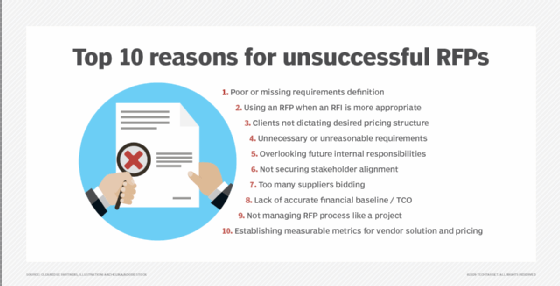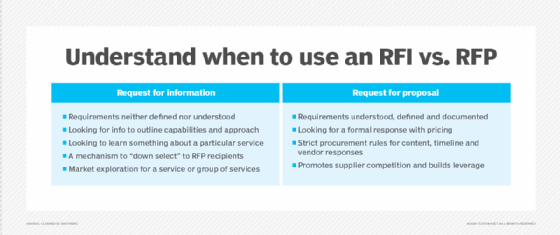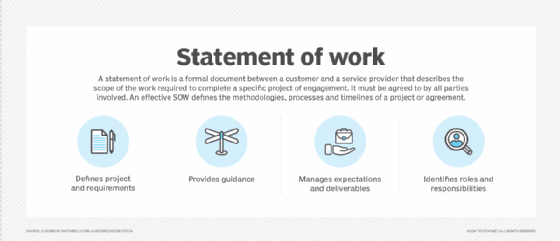How to write an RFP and statement of work for an IT services contract
Master how to write an RFP and statement of work to get the IT services you need using these best practices from consulting firm ClearEdge Partners.
CIOs spend hundreds of billions of dollars on professional IT services annually, with demand expected to grow sharply over the next five years.
Grandview Research, which pegged the global IT professional services market at $562 billion in 2017, has predicted an annual growth rate of 8.4%, propelling the value of IT professional services to $1.07 trillion by 2025.
With so much money at stake, not to mention countless IT service contract deliverables, enterprise IT leaders need to have strong processes for seeking a request for proposal (RFP) and developing the follow-on statement of work (SOW) that they'll use to engage with the selected vendor.
Many IT organizations, however, haven't mastered how to write an RFP that will elicit the right vendors or develop a statement of work that ensures they get the services they need, said Chris Powers, a managing partner at ClearEdge Partners, an IT service consulting firm, and his colleague James Faletra, a managing director and services practice lead.
"You would think with something of this size that IT would have a really good handle on it," Powers said. "But many clients struggle to [use the RFP and SOW] to maximize the value, as well as minimize risk."
Having worked for IT service providers before joining ClearEdge Partners, Powers and Faletra said they know what steps CIOs should take to gain better control of both the RFP and SOW processes.
 Chris Powers
Chris Powers
They shared their insights and offered best practices on how to write an RFP and SOW in an in-depth webinar, stressing that IT leaders must establish expectations and clearly define what they need from the start to ensure that they end up with the best deals and the best results.
"There are thousands of vendors out there delivering across all these different services, including a lot of manufacturers, software and hardware manufacturers, and cloud providers. They have all developed services because it is so profitable and it is so key to their technology," Powers said.
As a result, CIOs who have a developed process for how to engage service providers -- from the earliest stages through contract negotiations and service evaluation -- are best positioned to have good results with the myriad of vendors whom they hire.

How to write an RFP: 6 steps
 James Faletra
James Faletra
As demand from enterprise IT departments for professional services grows, Faletra said it's critical for IT leaders to use "a methodology based on best practices" as they develop and send out their RFPs.
"[A strong IT services contract] really does start with looking at an RFP and running it as a project," Faletra said. The following six steps explain how to write an RFP that is thorough, specific and is aligned with business needs:
- The first step is to start the process early enough to develop the request for proposal in detail and seek out multiple responses. "If you don't have an appropriate amount of time, you're going to potentially put yourself at a disadvantage," Faletra said.
- IT leaders need to be thorough in their list of requirements. "You have to build clear and accurate definition requirements," Powers said. "I don't mean just technical; it has to align to the business in terms of what is trying to be accomplished, what are those goals and how does the technology satisfy those key performance indicators." In addition, building an accurate demand model is important, so that the RFP responses are "aligned to the appropriate capacity that you're trying to implement," he said.
- Similarly, IT should be specific and detailed in the RFP with milestone dates.
- The RFP should be specific about what roles and responsibilities will be handled by internal resources and which will be handled by the service provider.
- IT should articulate in the RFP how a vendor's pricing should be presented and how it will be evaluated. By dictating the pricing structure, IT leaders gain transparency into how each vendor is arriving at its figures, making it easier for IT managers to compare what each vendor is really offering at what cost.
- IT should identify the right senior leaders in other departments, such as legal and security, involved in the procurement process to ensure that the work and requirements outlined in the RFP are aligned with those departments' expectations, needs and interests.
"What we see happen a lot with clients, in their interest to try to get an RFP out the door, is they cut back on a lot of these key elements, whether it's the comprehensive requirements definition, or thinking about how they want to get pricing, or whether they actually have enough information to actually generate an accurate RFP," Powers said.
"You end up doing yourself more harm than good when you do that," he added. Rushing to get a document out the door isn't going to give you much value, and it certainly isn't going to give you the leverage that you want downstream when you go to negotiate that contract."

Tips for writing an advantageous SOW
Once vendors submit their RFPs, and after senior leadership evaluates and selects a vendor to provide required services, Powers and Faletra said they advise IT leaders to manage the process for the SOW as diligently as they'd manage any tech project.
Their recommended steps for writing an effective SOW are as follows:
- Identify alternative vendors to pursue, so that IT has a Plan B if the negotiations with the selected vendor collapse. "It's always good to know you have a backup plan," Powers said, noting that IT departments will have more leverage negotiating the SOW if the vendor knows the client has other options.
- IT leaders should use the details around roles, responsibilities, pricing and other points presented in the RFP to craft the SOW.
- Be explicit about what work the vendor will do and what work internal staff will perform. Powers said he's always wary when he sees in SOWs comments like "joint responsibilities" or "joint ownership" between the vendor and the client "because then it's not really well-defined and that's a recipe potentially for an issue down the road."
- Be as specific as possible around requirements, metrics, milestones and pricing. Additionally, establish expectations or limits on where the vendor will perform the work (in-house, off-site, offshore).
"[Enterprise executives should] be able to pick up that document and fully understand exactly what we need to do, how we're going to do it, how many people we need to do it, and what infrastructure needs to go into it," Powell said. Indeed, the information in the SOW is critical to being able to actually assess whether the offer is a good price and whether the price is going to hold true for the life of the contract.
- Determine who owns any tools or supporting software programs developed as part of your IT services contract, so that IT knows that it will either have those tools and programs when the contract ends or if they walk out the door with the vendor.
- Outline clear service level and staffing expectations to ensure that neither slide during the length of the contract.
- Create a governance framework as part of the SOW document so that all these points can be monitored and managed.

For more best practices on how to write an RFP and statement of work for IT services, go to the ClearEdge webinar on Buying IT Services: RFP & SOW Best Practices.
About ClearEdge Partners
Founded by senior sales executives from large IT suppliers and informed by current market analytics, ClearEdge enables CIOs and their teams to make more competitive IT investments. By combining rigorous inspection and IT financial expertise, they identify risk and opportunity, align internal teams and maintain leverage throughout the lifecycle of supplier relationships. As a result, their clients maximize the value of their investments by unlocking millions of dollars from legacy spending and redirecting funds toward IT modernization, digital and cloud transformation with confidence and speed.






